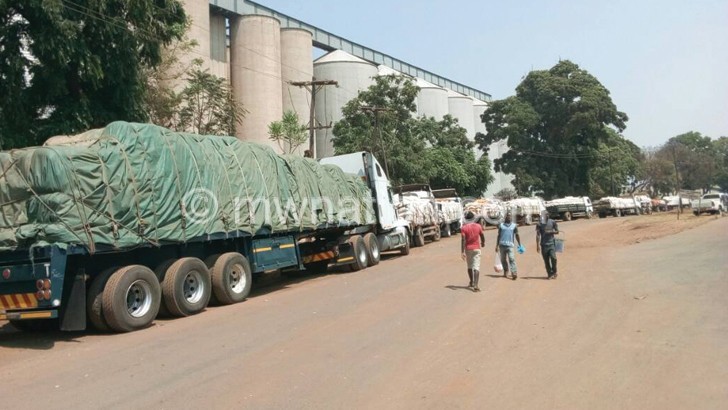Food security vicious cycle
It is the same old story. Billions of kwacha invested in food production through Farm Input Subsidy Programme (Fisp) and, at the end of the day, taxpayers fishing out more to feed millions of hungry mouths after poor harvest.
This time around, the country will need to raise about K20.8 billion to buy 138 488 metric tonnes (MT) of maize to feed 3.3 million people facing hunger until the next harvest in March 2019, according to the Malawi Vulnerability Assessment Committee (Mvac) Final Report released this week.

The required amount is in sharp contrast to the K7 billion allocated in the 2018/19 National Budget to the Department of Disaster Management Affairs (Dodma) for relief food, meaning that there is a K13.8 billion deficit.
But Dodma director Paul Kalilombe is optimistic despite the apparent deficit.
In an interview on Wednesday, he said Dodma will start distributing relief maize to all affected people mid this month until the next harvest.
Said Kalilombe: “Government has provided the department with food and the Ministry of Finance will provide the department with logistical support.
“Normally, when there is a situation like this one we ask for assistance from the Ministry of Finance. In this case, we asked for the maize to cater for the 3.3 million people. Let me reassure all Malawians that the situation is under control.”
Besides banking on Treasury, he said Dodma is also collaborating with other partners, including United Nations (UN) agencies such as the World Food Programme (WFP) which is responding to the situation.
In a statement released on Tuesday and signed by Secretary to the Treasury Ben Botolo, the 3 306 405 people residing in rural areas out of a projected national population of 17 931 637 will not be able to meet their annual food requirement during the 2018/19 consumption period. The figure represents 18 out of every 100 Malawians.
Reads the report: “The total humanitarian food required to support the affected people is estimated at 138 488 metric tonnes of maize with an estimated cash value of about K20.77 billion.
“The affected population has increased from 1 043 000 people during the 2017/18 consumption period to 3 306 405 people in this consumption season [April 2018 to March 2019].”
This year’s poor food output, mostly for maize—the country’s staple grain—is attributed to unfavourable weather conditions characterised by extended dry spells which caused moisture stress in almost all districts as well as fall armyworms.
While stressing that the affected population is spread nationwide, Botolo assured that government and its partners will implement response interventions to assist the affected population.
From the number of food insecure people, given that about K40 billion invested in Fisp benefitted 950 000 vulnerable smallholder farming households, at the rate of roughly six people per household, it means about 5.7 million people were set to reap the dividends.
Ironically, the 3.3 million is almost half the number of the Fisp beneficiaries.
WFP Malawi Office reports officer Cheu Mita said in a written response the organisation supports the Malawi Government through Dodma in terms of response planning and implementation.
She said: “WFP is aware of the Malawi Vulnerability Assessment Committee findings and will support Dodma and other stakeholders to come up with a response plan.”
Mita said WFP is also supporting Malawi in implementing social protection and development programmes through its school meals, nutrition and resilience building interventions in efforts to break the cycle of hunger.
She added that investing in long-term food security solutions remains high on WFP’s agenda in Malawi.
Said Mita: “Reaching over 723 000 participants across 10 shock-prone and food insecure districts, WFP under its multi-year resilience programme, is supporting asset creation activities in exchange of food or cash transfers that help meet immediate consumption gaps.”
Since its inception in 2005, Malawi has invested about K398.6 billion, an equivalent of a third of the current K1.4 trillion national budget, in Fisp, raising calls from opposition parties and other commentators—including Economics Association of Malawi (Ecama)—for government to abolish the programme because it is not achieving its intended purpose.
But despite observations that the initiative is a double cost as government subsidised production and at the same time consumption, authorities have stuck to the programme.
Critics of the subsidy programme have suggested increased investment in irrigation as a better alternative towards achieving household and national food security goals.
Recently, the UN’s Food and Agriculture Organisation (FAO) projected Malawi’s 2018 maize production to be around 3 million MT, with a decline of between 10 and 15 percent compared to the 2017 output, mainly reflecting the earlier dry spells.
Agriculture experts at the Southern Africa Development Community (Sadc) Secretariat also expressed fears that persistent low rainfall across the region is gradually causing crop moisture stress in some countries, leading to low harvests.
But the Mvac projections have not been without controversy as last year it estimated six million to face hunger only to transpire that the figure was less.





